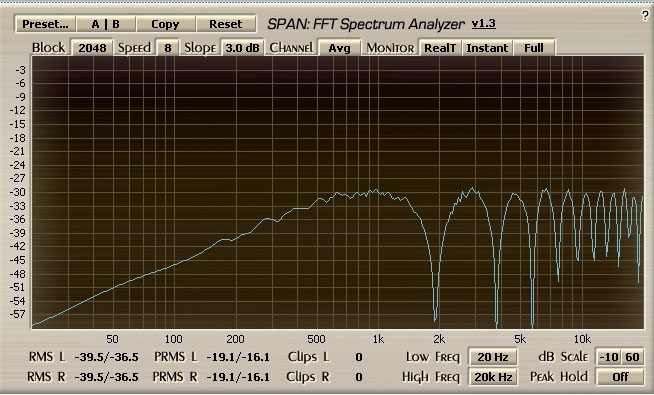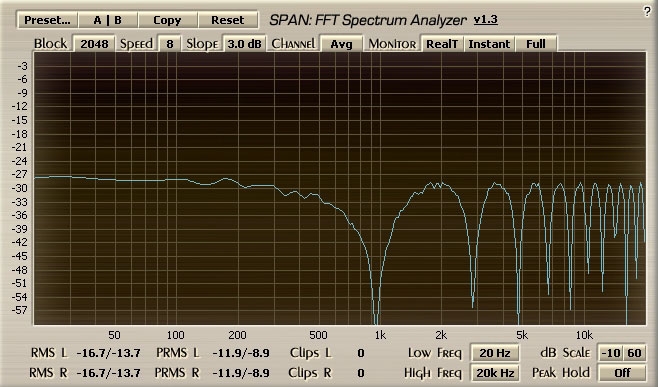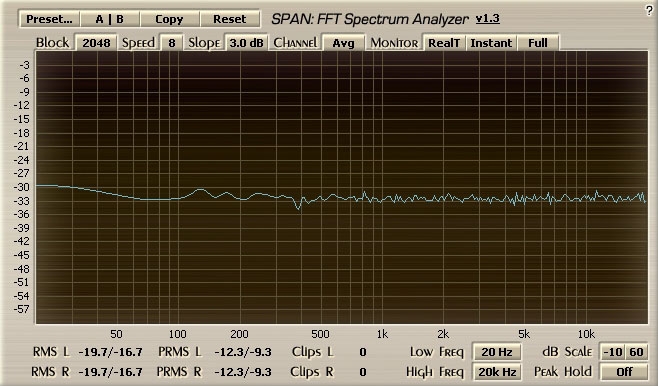
Now let’s look at the pink-noise spectra created with various delays between the two summed pink-noise tracks. When we mix the undelayed and delayed tracks, dips and peaks occur in the frequency spectrum at these frequencies:
A) Comb-filter frequency response with a 0.12 msec delay (Figure 6).
Fdip = 1/(2T) x 1, 3, 5… where T = the delay time in seconds.
Peaks occur at Fpeak = 1/T x 1, 2, 3, 4…
In this case,
Fdip = 1/(2T) x 1, 3, 5… = 4,166 Hz, 12,498 Hz…
Fpeak = 1/T x 1, 2, 3, 4… = 8,333 Hz, 16,666 Hz…
Listen to this effect here.

B) Comb-filter frequency response with a 0.5 msec delay (Figure 7).
Fdip = 1/(2T) x 1, 3, 5… = 1,000 Hz, 3,000 Hz, 5,000 Hz …
Fpeak = 1/T x 1, 2, 3, 4… = 2,000 Hz, 4,000 Hz, 6,000 Hz …
Listen to this effect here.

C) Comb-filter frequency response with a 1 msec delay (Figure 8).
Fdip = 1/(2T) x 1, 3, 5… = 500 Hz, 1,500 Hz, 2,500 Hz …
Fpeak = 1/T x 1, 2, 3, 4… = 1,000 Hz, 2,000 Hz, 3,000 Hz …
Listen to this effect here.

D) Comb-filter frequency response resulting from a 25 msec delay (Figure 9).
With a 25 msec delay, there’s essentially no comb filtering, but a 25 msec “flutter echo” effect can still be heard.
Listen to this effect here.

Another Variation
In the effect called flanging, the delay time is varied, so the frequency response changes. The peaks and dips move up and down the audio spectrum. As the delay is shortened, the harmonic content of the sound seems to rise in “pitch.”
Flanging is a variable comb filter. It gives a hollow, swishing, ethereal effect. Some recordings with flanging are “Itchycoo Park” by the Small Faces, “Open My Eyes” by the Nice, “Old John Robertson” by the Byrds, “Listen to the Music” by The Doobie Brothers, and “The Big Hurt” by Toni Fisher.
If the two signals are combined in opposite polarity, the low frequencies cancel (Figure 10). When you vary the delay (sweep through zero msec), the music sounds like it is turning inside out!

A Bit Of Math
For math geeks, the equation for comb filtering might be useful. After calculating the delay due to a path-length difference, you’ll know which frequencies will cancel. Source: A Scientific Explanation of Phasing (Flanging) by the author, Journal of the Audio Engineering Society, December 1970, page 674.
dB = 20 log ABS [2cos (pi F T)]
where dB = decibels
ABS = absolute value (because amplitude is always positive)
cos = cosine function
pi = 180 degrees (radian measure)
F = frequency in Hz
T = delay time in seconds
Comb filtering can be desirable as in a flanging effect, or it can degrade sound quality unless steps are taken to prevent it: use boundary mics on stage floors, follow the 3:1 rule, angle two directional mics apart, or mount them as a coincident pair.
